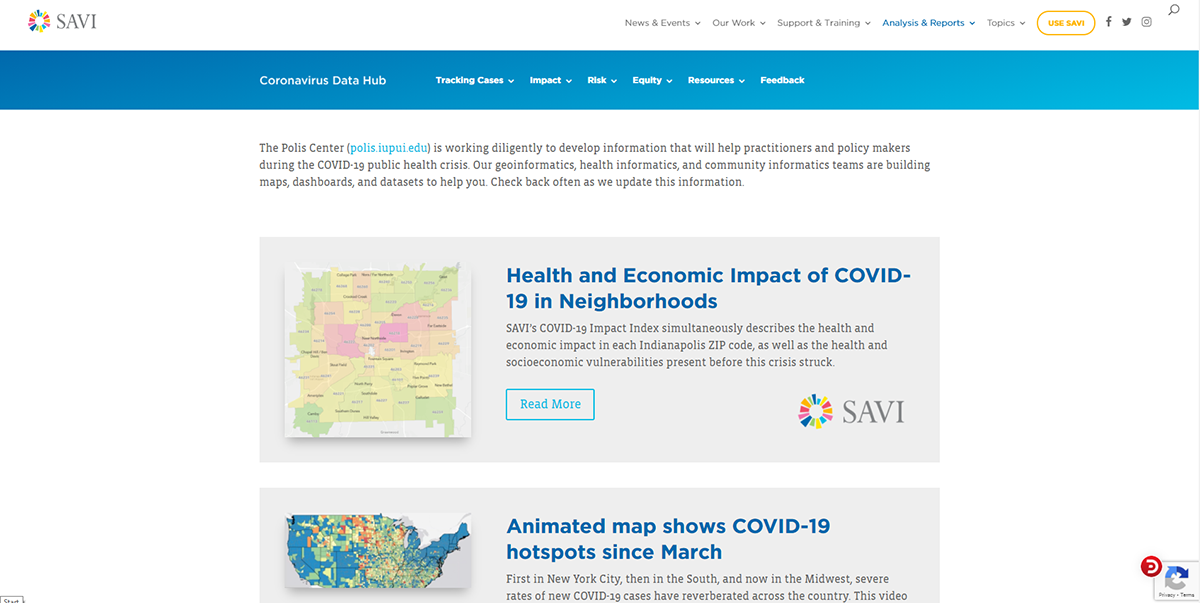Problem
Early on during the COVID-19 pandemic in 2020, there was little understanding of the crisis and little information available about vulnerable populations and communities to help policymakers make critical decisions quickly.


Early on during the COVID-19 pandemic in 2020, there was little understanding of the crisis and little information available about vulnerable populations and communities to help policymakers make critical decisions quickly.
COVID-19 inspired Polis to use its information, analytical capabilities, and technology to new ends. We already were engaged in projects that dealt with a number of similarly complex problems, ranging from the addiction crisis, domestic violence, poverty, aging, and disaster mitigation. We took the information we had about communities and vulnerable populations and put it one place using innovative technology, creating the SAVI Coronavirus Data Hub so people can access the info they need quickly.
The global pandemic dominated our attention in 2020 since its arrival in the U.S. Polis responded with technology to address the problems it presented, including the racial, social, and economic inequalities. This work, although spurred by the pandemic, was not new to us. COVID-19 inspired Polis to use its information, analytical capabilities, and technology to new ends. We already were engaged in projects that dealt with a number of similarly complex problems, ranging from the addiction crisis, domestic violence, poverty, aging, and disaster mitigation.
We took the information we had about communities and vulnerable populations and put it one place using innovative technology, creating the SAVI Coronavirus Data Hub so people can access the info they need to make critical decisions quickly. This information hub was the first of its kind early on when little understanding of the crisis was available. Its interactive capabilities make it unique by allowing users to explore detailed, community-specific data to understand the challenges, inequities, and impact of the pandemic.
The hub presents a lot of data in a variety of ways. It features maps, data, dashboards, reports, and articles to help guide decision-making of practitioners and policy makers during the COVID-19 public health crisis. Hub dashboards track confirmed cases, testing, and deaths for each county in Indiana and trends for U.S. counties. Hub content addresses social isolation in older adults, locations of emergency food/meals and community center service areas, inequalities, disparities for hard-hit or at-risk neighborhoods and populations, neighborhood risk factors in Bloomington and South Bend, COVID-19 impact on Indiana businesses, and needs by neighborhood (2-1-1 calls, unemployment claims, predicted eviction rates, and rental assistance applicants).
The hub tells a story about the impact of the pandemic on our community by putting data into context to help people understand the implications it has on service delivery, showing vulnerable areas where funds should be directed, and how to be forward looking in planning.
We published 23 tools, research articles and reports. With over 418,000 views in 2020, the hub continues to serve the information needs of thousands of civic leaders, nonprofits, funders, media, and researchers from many sectors across the state. A few examples of use, often in collaboration with The Polis Center include:
The Indiana Geographic Information Council (IGIC) awarded the Special Achievement in GIS for the hub demonstrating the power of using teamwork, collaboration, and GIS to address pressing community challenges. Watch overview video here.
For more information, contact Sharon Kandris.